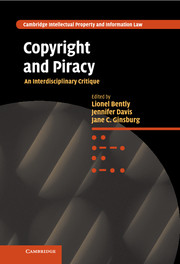Book contents
- Frontmatter
- Contents
- Notes on the contributors
- Editors' preface
- Table of cases
- Table of statutes
- Part I Introduction
- Part II History
- Part III Comparative Law
- Part IV Economics
- 6 Copyright infringement, ‘free-riding’ and the lifeworld
- 7 Copyright and the limits of law-and-economics analysis
- Part V Linguistics
- Part VI Computer software
- Part VII Information studies
- Part VIII Literature
- Part IX Art
- Part X Sociology/music
- Part XI Criminology
- Bibliography
- Index
6 - Copyright infringement, ‘free-riding’ and the lifeworld
from Part IV - Economics
Published online by Cambridge University Press: 17 November 2010
- Frontmatter
- Contents
- Notes on the contributors
- Editors' preface
- Table of cases
- Table of statutes
- Part I Introduction
- Part II History
- Part III Comparative Law
- Part IV Economics
- 6 Copyright infringement, ‘free-riding’ and the lifeworld
- 7 Copyright and the limits of law-and-economics analysis
- Part V Linguistics
- Part VI Computer software
- Part VII Information studies
- Part VIII Literature
- Part IX Art
- Part X Sociology/music
- Part XI Criminology
- Bibliography
- Index
Summary
Introduction
There is now a voluminous international literature on copyright law, policy and theory. Yet despite its apparent diversity, much of this commentary (particularly the very large proportion that emanates from authors based in the United States) is underpinned by the same unquestioned assumption: that some version of economic efficiency – the achievement of which involves balancing the social costs of activities (such as creating cultural artefacts and controlling how these are used) against the benefits of those activities – is the crucial, if not the only, criterion for evaluating both the copyright system and the field that it regulates. Commentators may have different understandings of how costs and benefits should be measured, and of how private costs and benefits can be made to match up with social costs and benefits, but the idea that a cost–benefit equation is the acid test of defensible analysis and policy in this area is rarely challenged. Among the more overtly committed of law-and-economics (L&E) scholars, this general idea tends to be invoked in relation to a cluster of rather more technical categories of economic analysis, and some of these – notably the concepts of public good and externality – are particularly relevant to the project of explaining, and prescribing for, copyright law in economic terms. Very briefly, the premise of this project is that information ‘goods’ are often difficult and expensive to create; yet once produced, they tend towards the condition of public goods – they are non-rivalrous in consumption, and relatively non-excludable.
- Type
- Chapter
- Information
- Copyright and PiracyAn Interdisciplinary Critique, pp. 93 - 127Publisher: Cambridge University PressPrint publication year: 2010
- 2
- Cited by



